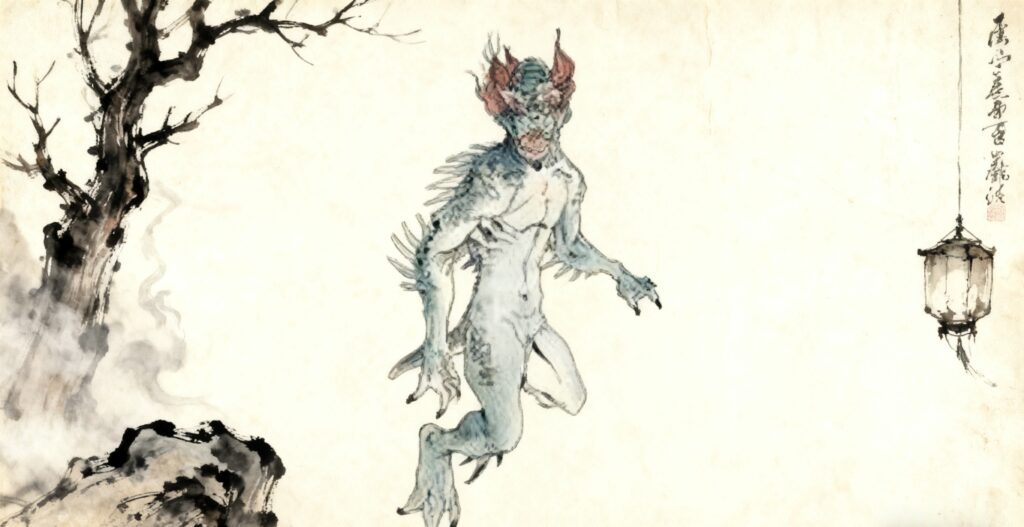Chinese ghost culture is one of the most profound and symbolic in the world. While Western traditions like Halloween focus on playfully confronting fear and the unknown, Chinese ghost beliefs reflect a deeper moral and spiritual dimension. Here, ghosts are not just frightening figures — they embody justice, emotion, and the balance between life and death. Rooted in ancient rituals and evolving through modern stories, Chinese ghost folklore reveals how people seek harmony with unseen forces, offering a thoughtful contrast to the Western way of celebrating the supernatural.
Part I: The Traditional Types of Ghosts
Lìguǐ (厉鬼) – The Vengeful Spirit
Born from deep resentment or injustice, these spirits cannot reincarnate until their grievances are resolved. They are said to appear in the misty hours before sunrise, seeking to exchange lives so they may finally rest.
Shuǐguǐ (水鬼) – The Drowned Ghost
Known as “the drowned souls,” these ghosts are believed to pull others underwater to take their place. Fishermen tell of laughter echoing across rivers or invisible hands dragging swimmers down — warnings of a restless spirit seeking release.
Mùguǐ (墓鬼) – The Graveyard Spirit
These quiet souls linger in graveyards, not out of malice but longing. They are patient, waiting for their next rebirth, though they may frighten wanderers with floating lights or eerie sounds among the tombs.
Chāngguǐ (伥鬼) – The Tiger’s Servant Ghost
Those devoured by tigers are said to become bound to them, guiding the beasts toward human prey. Men are missing their left little finger, women their right — silent marks of their tragic servitude.
Chǎnguǐ (产鬼) – The Childbirth Ghost
Women who die during childbirth are believed to return as spirits that harm pregnant women. Ancient stories describe them with a crimson line around the throat — a symbol of their suffering and warning of their wrath.
Yìguǐ (缢鬼) – The Hanging Ghost
Bound eternally to the rope that ended their life, these ghosts wander, reliving their final pain. They can only be freed through karmic substitution — when another dies the same way.
Māoguǐ (猫鬼) – The Cat Spirit
Said to arise from the reanimation of dead cats through dark rituals, these creatures prowl at night. Larger than normal cats with long fur and glowing eyes, they are drawn to sesame oil chicken and are feared for harming infants in their sleep.
Yìguǐ (疫鬼) – The Plague Ghost
Descended from Zhuanxu’s eldest son, this ghost spreads pestilence. Carrying a red lantern, it moves through walls unseen and is blamed for sudden outbreaks that once devastated entire villages.
Wǎngliǎng (魍魉鬼) – The Mountain Demon Ghost
Said to be born from Zhuanxu’s other son, these childlike beings live in forests with red eyes and long ears. They mimic human voices to confuse travelers and bring illness but fear the sound of drums.
Xiǎo’érguǐ (小儿鬼) – The Child Ghost
Known as “Night-Crying Ghosts,” these are the souls of children who died young. They hover near sleeping infants, causing restlessness or tears. Their presence evokes both sorrow and compassion.
Part II: Ghosts in Modern Urban Legends
Water Ghosts in the Modern Age
The belief in drowned ghosts seeking substitutes endures. Fishermen and night swimmers still tell of laughter by the river or ripples forming without wind — signs of spirits bound to water.
Child Ghosts and Haunted Buildings
In modern Shanghai, the story “Baby, I’m Sorry” echoes the xiǎo’érguǐ legend. Security guards in quiet malls report hearing children cry at night — said to be echoes of souls from an old orphanage below.
Childbirth Ghosts in Folktales
Qing-era writings like Licheng by Xu Feng’en tell of childbirth ghosts attacking pregnant women. To protect against them, women placed two open umbrellas beside the bed — symbols to block spiritual intrusion.
Hanging Ghosts in Urban Sites
Old buildings with tragic pasts often become sites of rumor. Visitors speak of invisible pressure on their necks or strange creaks from empty rooms — chilling reminders of yìguǐ’s lingering sorrow.
Cat Ghosts and Modern Curses
Tales of “cat shamans” still circulate in rural towns. People whisper about black cats that follow them after curses or ghostly meows before misfortune — a haunting mix of folklore and superstition that endures even in the digital age.
Part III: Cultural Reflections
Moral and Spiritual Meaning
Chinese ghost stories are rarely just tales of terror. Each ghost represents an imbalance — grief, revenge, or desire. Through ritual and virtue, people seek to restore harmony, reminding us that every action carries consequence, both in life and beyond.
Modern Relevance
Today, these stories live on through films, online tales, and temple festivals. Whether believed literally or metaphorically, they express deep respect for moral order, the afterlife, and the unseen ties between the living and the dead.
Possible FAQ Section
Q1: Why are ghosts so important in Chinese culture?
Becausethey symbolize the belief that every deed has consequences — a reflection of justice that continues beyond death.
Q2: Are all ghosts harmful?
Not always. Some, like graveyard spirits, are peaceful observers. Others act from pain or injustice, not from pure evil.
Q3: Do modern Chinese people still believe in ghosts?
Beliefs vary, but ghost stories remain vital in festivals like the Ghost Festival and in contemporary media, preserving ancient lessons about respect, karma, and life’s spiritual continuity.
